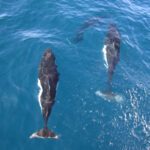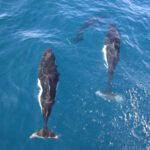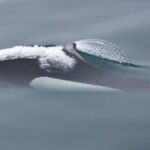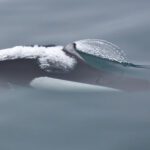Porpoises – these small and clever marine mammals, often mistaken for dolphins, belong to the family Phocoenidae. They have a streamlined body and a curved dorsal fin, making them perfect for life in the ocean.
They are known for their playful behavior and strong social bonds with their pod. Porpoises live in coastal waters of the Northern Hemisphere, including the North Atlantic and Pacific Oceans.
Hunting fish and squid with their spade-shaped teeth, they use their special ability of echolocating to navigate underwater, find food and even communicate with their pod.
Scientists have been studying porpoises for many years now. Dr. Sarah Mesnick from NOAA’s Southwest Fisheries Science Center recently revealed that harbor porpoises in California waters make different vocalizations depending on their location.
Key Takeaways
- Porpoises are small marine mammals that belong to the same family as dolphins and whales.
- They are known for their streamlined bodies, small size, and triangular dorsal fins.
- Porpoises are highly intelligent and social animals, often found in groups called pods.
- They primarily feed on fish and squid, using echolocation to locate their prey.
- There are several different species of porpoises, including the harbor porpoise, Dall’s porpoise, and the vaquita.
- Porpoises face various threats, including habitat loss, pollution, and accidental entanglement in fishing gear.
- Conservation efforts are being made to protect porpoise populations and their habitats.
- Porpoises play an important role in marine ecosystems, contributing to the balance of the food chain.
- They are also popular attractions for eco-tourism, with many people enjoying the opportunity to observe these fascinating creatures in their natural habitats.
- Overall, porpoises are fascinating marine mammals that deserve our attention and protection.
Characteristics of Porpoises

To understand the characteristics of porpoises, delve into their physical appearance, habitat and distribution, and behavior and communication. Explore the unique features that define these creatures, the environments they inhabit, and how they behave and communicate within their social groups.
Physical Appearance
Porpoises are distinct from other marine mammals. Their streamlined bodies give them speed and agility in their oceanic environment.
A look at porpoises shows their special features. They have a slim body that tapers at the back and dark gray to black colors on their upper body. This provides them with camouflage, helping them hide from predators.
Let’s explore more of their appearance. Porpoises vary in size, the smallest being the vaquita which measure 1.2-1.5 meters long. The Dall’s porpoise can reach 2.1 meters. They have strong muscles, especially around their fins and flukes. This lets them swim swiftly. They have a triangular dorsal fin on their back. This helps them stay stable and maneuver quickly. They also have sharp teeth for hunting.
Porpoises have been on Earth for 23 million years. They’ve evolved to live in various oceanic habitats. But they avoid crowded beach resorts because they like the peacefulness of the ocean.
Habitat and Distribution
Porpoises have an impressive range of habitats, from coastal to open ocean waters. They can even handle warm and cold climates. To understand their habitat and distribution better, take a look at the following table:
| Porpoise Species | Habitat | Distribution |
|---|---|---|
| Common Porpoise | Coastal | Worldwide |
| Dall’s Porpoise | Open Ocean | North Pacific |
| Spectacled Porpoise | Oceanic waters | Southern Hemisphere |
Plus, certain species show seasonal movements, influenced by factors like temperature and prey availability. This adds more complexity to their distribution patterns.
To conserve porpoises, there are some important steps to take. Like creating marine protected areas, minimizing bycatch, monitoring populations, and cooperating internationally. Doing this helps us protect porpoises, while also looking after the marine ecosystem.
And for those of us who are tired of small talk, porpoises make great companions. They’ve mastered the art of silent communication!
Behavior and Communication
Porpoises have captivating behaviors and peculiar ways of conversing with each other. These traits show the complexity and intelligence of these aquatic mammals.
Behaviors
- Social
- Lively
- Inquisitive
Communication
- Whistles
- Clicks
- Physical contact
These wonderful creatures take part in distinct activities to communicate with their group. They are very social animals, forming strong groups that promote a feeling of companionship and assistance. Porpoises make a series of whistles to disperse info, possibly being a way to keep social connections within their group. Moreover, they create clicks which may be a form of echolocation, letting them to voyage through their underwater environment and detect prey.
In addition to their usual communication techniques, porpoises also use physical contact to transmit messages. They take part in lively behavior, taking part in acrobatic performances such as leaping out of the water or riding waves created by boats. These acts not only provide entertainment but may also act as a signal for playfulness or appeal for social interaction.
On the coasts of Cornwall, a bewitching experience took place between a swimming enthusiast and a curious harbor porpoise. As the swimmer plunged into the depths of the ocean, the porpoise joined in on the lively escapade, encircling agilely around the swimmer. This unexpected connection showed both the merry character and amiable temper of these extraordinary creatures.
Explore the exhilarating world of porpoises, where they exist in various sizes and shapes, proving that even the sea has its own version of a high school clique.
Different Types of Porpoises
To learn about the different types of porpoises – harbor porpoise, Dall’s porpoise, and spectacled porpoise – we’ll explore their unique characteristics and habitats. Discover the distinct features and behaviors of each porpoise species, providing an in-depth look into their fascinating world beneath the waves.
Harbor Porpoise
The Harbor Porpoise is a species of porpoise commonly found in coastal waters. It has a dark hue with a triangular fin on its back. It’s around 5 to 6 feet long and weighs 110 to 150 pounds. It’s known for its speed, reaching up to 18 mph. Its scientific name is Phocoena phocoena and it lives in the coastal areas. It feeds on small fish and squid. It can live up to 20 years and gives birth to live young. It is listed as a species of least concern.
It has small spade-shaped teeth, ideal for catching prey. Plus, it has great echolocation skills to locate and capture food easily. If you ever spot one in the wild, don’t bother it – just watch from afar!
Dall’s Porpoise – they’re like Orcas but faster. They have black and white colors and they zoom around eating their favorite food, sushi.
Dall’s Porpoise
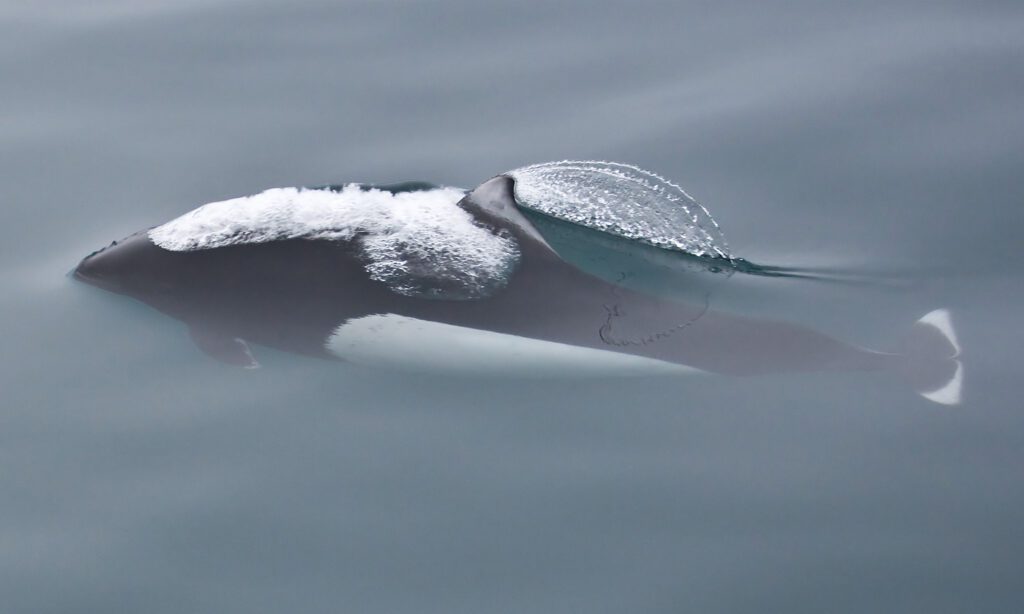
licensed under (CC BY-SA 2.0)
Dall’s Porpoise is the real wizard of the sea! They have a slim, streamlined body that lets them swim up to 30 miles per hour, making them one of the speediest marine mammals. On average, these porpoises measure 6-7 feet and weigh 300-500 pounds.
Their distinct color pattern is striking; their upper body is black and the lower part is white. To top off their look, they have a large dorsal fin on their back.
These porpoises are quite adventurous, often riding bow waves created by boats or ships. Plus, they have a playful nature and love to show off their acrobatic skills.
In 1865, William Healey Dall discovered this species on an Alaskan coastal expedition. Hence, it was named after him as a tribute to his contributions in natural history.
In summary, Dall’s Porpoise is a charming and awe-inspiring creature that will captivate you with its swift movements and joyful demeanor.
Spectacled Porpoise
The Spectacled Porpoise is a mysterious marine mammal that belongs to the toothed whale family. It is easily recognized by its unique black and white markings around its eyes, resembling spectacles. This species has an average size of 1.6 to 2.1 meters.
They inhabit cold temperate waters of the Southern Ocean, such as Argentina, Chile, New Zealand, and South Georgia. They prefer deep offshore habitats and are rarely close to shore.
Georges Cuvier, a famous French naturalist and zoologist, first described this species in 1825. Since then, researchers have been enthralled by their unique markings and reclusive nature.
The Spectacled Porpoise stands out with its distinct appearance and habitat preferences. The information gathered throughout history has provided valuable insight into this captivating species. Porpoises may not have thumbs, but their adaptations give them the power to survive.
Adaptations and Survival Skills of Porpoises

To understand the adaptations and survival skills of porpoises, delve into the world of these fascinating marine creatures. Discover the techniques they employ for echolocation, feeding habits, and their complex social structure. Uncover how these unique aspects contribute to their ability to thrive in their oceanic environment.
Echolocation
Porpoises possess an amazing ability – echolocation! This unique adaptation helps them to navigate and find prey using sound waves. Echolocation works by sending out clicking sounds that travel through water. When these sounds hit objects, they bounce back as echoes. Porpoises interpret the intensity and timing of the echoes to find out the location, size and shape of objects.
To understand echolocation further, let’s look at a few key details: Frequency, Beamwidth and Range. Porpoises emit clicks of high frequencies – usually between 100 kHz and 150 kHz. They also have a narrow beamwidth so sound waves focus in a specific direction. They have a range of several hundred meters, giving them a wide area to perceive.
Other marine mammals, like dolphins and whales, also use echolocation for various purposes. It is interesting to note that humans have been inspired by this natural sonar system too. Sonar technology used in submarines has been based on porpoises’ and other cetaceans’ techniques. Scientists continue to learn valuable insights about underwater navigation from them.
All in all, echolocation is a crucial adaptation for porpoises to survive in their environment. It helps them to accurately locate food sources and stay away from potential threats. So while these animals have perfected the art of adaptation, when it comes to feeding, it’s all about snack time survival!
Feeding Habits
Porpoises have remarkable feeding habits. They use echolocation to detect prey and can swim up to 35 miles per hour (56 km/h). They also showcase their versatility with different strategies. For example, they can remain motionless and camouflaged, or work together to herd fish. These adaptations help them adapt and survive.
Plus, porpoises can use specialized jaw structures to eat various types of prey. This helps them thrive in marine ecosystems worldwide. All these skills make them apex predators that deserve admiration.
Social Structure
Porpoises possess a special social structure. Small pods are tightly-knit, and large pods are more extended.
Communication is vital for their success. Clicks, whistles, and body language help them coordinate hunting strategies. Younger members learn from older ones through observation and imitation.
Once, off the coast of California, a pod of porpoises displayed remarkable teamwork. With perfect coordination and individual roles, they surrounded a school of fish, blocking all escape routes. This highlighted how their social structure strengthens their chances of survival.
The porpoise social structure is captivating. It reveals their adaptability and survival skills. By exploring this topic, we can admire their complexity and beauty.
Conservation efforts are working hard to protect porpoises, whose threats are as unpredictable as a porpoise in a paintball match!
Threats and Conservation Efforts for Porpoises
To address the threats to porpoises and promote their conservation, this section delves into the various factors affecting them. Learn about the detrimental effects of human activities and the proactive measures taken to protect porpoises. Additionally, discover the role of conservation organizations in safeguarding these remarkable creatures.
Human Activities and Impact
Human activities have a huge effect on porpoise conservation. Their existence is facing peril due to human actions, so urgent steps must be taken.
- Pollution: Industrial and agricultural waste is seeping into the seas, polluting the water and disturbing porpoises’ environment. This pollution not only harms their health, but also their food-finding ability.
- Fishing procedures: Porpoises often become victims of bycatch, getting tangled in fishing nets or trapped in fishing gear meant for other species. These unintentional captures pose a major danger and can lead to population decline.
- Habitat destruction: Coastal development projects, such as construction and dredging, can destroy the delicate habitats where porpoises live and breed. This loss of suitable habitat decreases their chances of survival and reproduction.
- Noise pollution: Underwater noise from ships, seismic exploration, and military sonar systems disrupts porpoises’ communication, feeding, and navigation abilities. Continuous exposure to too much noise can result in long-term consequences for their population.
- Climate change: Rising sea levels, ocean acidification, and changes in water temperature affect the availability of prey species for porpoises. The shifting climate patterns make it hard for these marine mammals to cope with fast environmental changes.
To reduce these impacts on porpoise conservation, there are some suggestions:
- Firm regulations must be enforced to control industrial pollution entering our oceans. This should involve good waste management systems by industries and monitoring their compliance.
- Using selective fishing methods that reduce bycatch is vital for protecting porpoise populations. The use of specialized fishing gear built to exclude unintended marine species can help minimize accidental entanglement.
- Implementing coastal development projects with proper environmental impact assessments can safeguard vital porpoise habitats. It’s essential to prioritize conservation while allowing for sustainable development.
- Steps should be taken to reduce underwater noise levels by adopting quieter shipping technologies and implementing guidelines for responsible sonar use in military operations.
Furthermore, addressing climate change through global initiatives is essential for the long-term survival of porpoises. Reducing greenhouse gas emissions and promoting sustainable practices can help counteract the adverse effects of climate change on their habitats and prey availability.
By taking these steps, we can lessen the bad impacts of human activities on porpoise conservation. It’s essential to prioritize their protection and ensure a sustainable future for these amazing marine creatures. Conservation organizations are like superheroes for porpoises, using their great power to combat threats and make waves in the world of marine conservation.
Protective Measures and Conservation Organizations
Conservation groups are key to safeguarding porpoises and their habitats. These initiatives are essential for their long-term survival.
- Research and monitoring: Conservation orgs explore porpoise populations, their habits, and habitat needs. This helps craft successful conservation plans.
- Habitat protection: Critical porpoise habitats are identified and protected areas established; human activities are regulated to reduce disturbances and up their chances.
- Collaborative efforts: Conservation orgs join forces with gov’t bodies, local people, and other stakeholders for a cohesive conservation strategy.
- Public awareness campaigns: Spreading the word about porpoise conservation is vital. Educational programs, workshops, and outreach events help people contribute.
- Legislation and policy advocacy: Conservation orgs strive for legislation and policies that support porpoise protection. They engage in policy-making to influence decisions.
Despite obstacles such as scarce resources or differing priorities, conservation groups press on with porpoise conservation.
To further strengthen protective measures:
- Collaborative research: Scientists from different disciplines joining forces can bring fresh ideas to porpoise conservation. Combining biology, ecology, oceanography, and tech know-how can help understand threats and devise solutions.
- International cooperation: Porpoises migrate across international waters, so nations must cooperate. Exchanging info and coordinating efforts is essential.
- Funding support: Research, conservation programs, and capacity building need sufficient funds. Governments, philanthropists, and international funders should prioritize support.
By putting these ideas into action, protective measures can be enhanced, leading to more successful porpoise conservation. Research, collaboration, raising awareness, and strong policy will enable these marvellous mammals to be preserved for future generations.
Porpoises in Culture and History
To better understand the cultural and historical significance of porpoises, explore their portrayal in mythology and folklore, as well as their representation in art and literature. These sub-sections shed light on how porpoises have been woven into the fabric of human culture, both as mythical beings and as subjects of artistic inspiration.
Mythology and Folklore
Ancient cultures around the world highly respected porpoises. They believed these creatures had special powers and symbolic meanings. Let’s explore their prominent role in mythology and folklore.
Porpoises were seen as spiritual beings, with divine qualities of protection, guidance and transformation. This belief was based on their gentle nature and intelligence.
In Greek mythology, Poseidon, the god of the sea, is said to have transformed himself into a porpoise to rule the water. Chinese folklore said porpoises were shape-shifting mermaids, who protected sailors from danger. The Māori people believe porpoises, called Tohora, were guardians and protectors of their coastal towns.
Egyptians also revered porpoises, believing they brought abundance and fertility. They featured in artwork and were even mummified with pharaohs.
In the 1950s, the tradition of “swim with dolphins” began in Norfolk County, England. This gave people the chance to interact with these majestic creatures.
The mythology and folklore of porpoises has endured throughout history. Porpoises have inspired art, like dolphin-tattoos and porpoise-paintings. All without harming any dolphins!
Porpoises in Art and Literature
Porpoises have made their mark in art and literature. They appear in paintings, sculptures, murals, and more. Representing freedom and joy, they add serenity to creative expressions.
In literature, porpoises appear as mysterious characters. From ancient myths to contemporary novels, they guide readers on epic journeys.
John Singer Sargent, Salvador Dali, and Herman Melville all featured porpoises in their works. Each captivating piece conveys different emotions and themes.
Ancient Egyptians connected porpoises to protection. Romans considered them sacred to the god Apollo.
To use porpoises in your own creativity, consider these ideas:
- Let them evoke tranquility and beauty.
- Explore their symbolism in different cultures.
- Research their historical events.
Incorporate porpoises into your art and let their presence enhance your journey. Admire their enigmatic nature and let their cuteness captivate you.
Frequently Asked Questions
Q: What are porpoises?
A: Porpoises are small cetacean mammals that are closely related to dolphins. They belong to the family Phocoenidae and are known for their sleek bodies and triangular dorsal fins.
Q: How do porpoises differ from dolphins?
A: Porpoises and dolphins are similar in many ways, but there are some key differences. Porpoises have a stockier body shape compared to the streamlined body of dolphins. Porpoises also have a shorter snout, fewer teeth, and lack the signature ‘beak’ shape that dolphins have.
Q: Where do porpoises live?
A: Porpoises are found in oceans and seas around the world, although they tend to prefer cooler, coastal waters. They can be found in the North Atlantic, North Pacific, and other temperate to polar regions.
Q: What do porpoises eat?
A: Porpoises primarily feed on small fish, such as herring, cod, and squid. They are skilled hunters and use echolocation to locate their prey in the water.
Q: Are porpoises endangered?
A: Some species of porpoises are considered endangered or vulnerable due to factors like pollution, habitat loss, and accidental entanglement in fishing gear. Conservation efforts are underway to protect and preserve these species.
Q: Can porpoises communicate with each other?
A: Yes, porpoises are highly social animals and communicate with each other using clicks, whistles, and body movements. They use echolocation not only for hunting but also for communication and navigation.
Conclusion
Porpoises are vital for maintaining ecosystem balance. They regulate prey populations and serve as a sign of ocean health. Their hunting helps keep the balance in their habitats. This benefits other marine life and us humans too. Protecting porpoises safeguards the equilibrium of our oceans. This allows many species to live harmoniously.
Porpoises are also good indicators of ocean health. They are sensitive to changes in water quality and pollution. So, protecting them helps us keep our marine ecosystems healthy.
Supporting conservation efforts is key to protect porpoises. We should reduce pollution, preserve habitats, and advocate responsible fishing practices. Let’s work together to safeguard these gentle giants and secure a sustainable future for our oceans.
References

